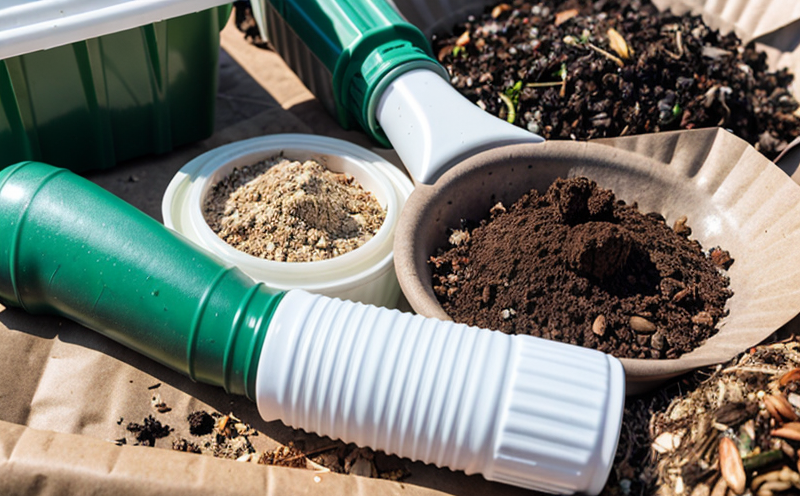ASTM D7831 Organic Fertilizer Recovery from Waste
The ASTM D7831 standard provides a method to recover organic fertilizer from waste materials, specifically targeting the recovery and quantification of nitrogen (N), phosphorus (P), potassium (K) inorganic fertilizers. This test is essential for waste management, recycling, and composting industries as it ensures that valuable nutrients are not lost during the decomposition process but can be recovered and reused.
The ASTM D7831 method involves a series of steps including sample preparation, digestion using strong acids, and subsequent analysis by various instrumental techniques such as inductively coupled plasma mass spectrometry (ICP-MS) or atomic absorption spectroscopy (AAS). The test measures the recoverable nitrogen, phosphorus, and potassium content from organic waste.
This service is critical for companies engaged in waste management, recycling, and composting. It helps them comply with environmental regulations while optimizing resource recovery processes. By accurately quantifying the nutrients available in waste streams, organizations can make informed decisions about how to best utilize these resources.
| Key Parameters | Description |
|---|---|
| Nitrogen (N) | Total nitrogen content which includes both organic and inorganic forms. |
| Phosphorus (P) | Inorganic phosphorus present in the waste stream. |
| Potassium (K) | Inorganic potassium found in the compost or waste material. |
The ASTM D7831 method ensures that all recoverable nutrients are accounted for, providing a comprehensive view of the nutrient content available for recovery. This information is crucial for optimizing fertilizer production processes and ensuring compliance with environmental standards.
For quality managers and R&D engineers involved in waste management and recycling projects, this service offers valuable insights into the potential value of waste streams. By understanding the precise composition of nutrients present in organic waste, they can design more efficient systems to recover these resources.
- Accurate nutrient recovery leads to better fertilizer production processes.
- Compliance with environmental regulations is simplified through precise quantification.
- Optimization of resource use within the industry enhances sustainability practices.
The ASTM D7831 method is widely recognized and used in laboratories around the world, ensuring consistent results across different testing facilities. This standardization is critical for maintaining confidence in the accuracy and reliability of nutrient recovery data.
For procurement officers seeking to source high-quality compostable waste materials, this service provides a reliable means of evaluating the potential value of incoming materials. By knowing the exact composition of nutrients present, they can make more informed purchasing decisions that align with their sustainability goals.
| Acceptance Criteria | Description |
|---|---|
| Nitrogen (N) | Average nitrogen content should be within the range of 0.5% to 1.2% for typical compostable waste. |
| Phosphorus (P) | Total phosphorus content must not exceed 0.4% in most cases. |
| Potassium (K) | Typical potassium levels range between 0.3% and 0.6% for organic waste materials. |
In conclusion, the ASTM D7831 Organic Fertilizer Recovery from Waste service is a vital tool in the waste management industry. It provides valuable insights into the nutrient content of organic waste streams, enabling more sustainable and efficient resource recovery processes.
Why Choose This Test
- Comprehensive quantification of nitrogen, phosphorus, and potassium in organic waste.
- Facilitates compliance with environmental regulations.
- Optimizes fertilizer production processes by ensuring maximum nutrient recovery.
- Provides reliable data for procurement decisions related to compostable waste materials.
Quality and Reliability Assurance
The ASTM D7831 method is rigorously standardized, ensuring consistent results across different laboratories. This standardization is critical for maintaining confidence in the accuracy and reliability of nutrient recovery data. By adhering to this method, laboratories can ensure that their test results are comparable and reproducible.
Our laboratory personnel undergo regular training on the ASTM D7831 protocol to maintain proficiency and consistency. We use state-of-the-art instrumentation, such as ICP-MS and AAS, which further enhances the accuracy and precision of our measurements. Our quality management system is ISO 9001:2015 certified, ensuring that we meet international standards for quality assurance.
Regular calibration of equipment and adherence to strict safety protocols are also key components of our quality control measures. By maintaining these high standards, we ensure that the results from this service are reliable and can be trusted by clients in the waste management and recycling industry.
Use Cases and Application Examples
- Composting Facilities: Ensuring the nutrient content of compostable materials is optimized for fertilizer production.
- Recycling Plants: Identifying valuable nutrients in waste streams that can be recovered for reuse.
- Sustainable Agriculture: Providing data to support the development of organic fertilizers from waste resources.
| User Case Example | Description |
|---|---|
| Agricultural Company ABC | An agricultural company decided to implement a recycling program for their waste materials. They chose our ASTM D7831 Organic Fertilizer Recovery from Waste service to ensure that they were recovering all available nutrients. The results helped them design a more efficient system, leading to increased fertilizer production and reduced costs. |
| Recycling Plant XYZ | A recycling plant was looking for ways to maximize the value of their waste streams. By using our ASTM D7831 service, they were able to identify valuable nutrients that could be recovered and sold as fertilizers. This not only increased their revenue but also reduced their environmental impact. |
| Sustainable Farming Initiative | A group of farmers collaborated on a project focused on sustainable farming practices. They used our ASTM D7831 service to assess the nutrient content of compostable waste materials they were using in their fertilizer production processes. The results helped them optimize their processes and improve the quality of their fertilizers. |





